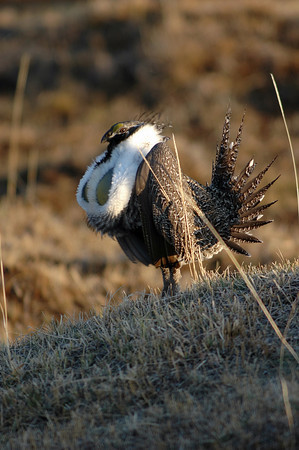Some information may be outdated.
The Grand County Council voted to send a letter to the Forest Service and Bureau of Land Management (BLM) officials to express their support of the state’s sage grouse management plan at their special meeting held Tuesday morning, April 30.
The state’s plan, released April 24, aimed to invite greater sage grouse by restoring sagebrush burned by wildfires and overtaken by juniper.
Objectives of the plan include: protecting 10,000 acres of the best sage grouse habitat annually; enhancing 25,000 acres of existing sage grouse habitat annually; and increasing the total amount of sage grouse habitat by 50,000 acres annually.
The plan comes as federal officials are considering naming the birds as an endangered species in 2015.
Utah Public Lands Director Kathleen Clarke said the “endangered” label would impose a costly and burdensome slew regulations on Utah.
Utah is home to about eight percent of the greater sage grouse in the West. The state’s population naturally fluctuates, depending on the year. Biologists now estimate a range of 16,000 to 34,000 birds according to the Division of Wildlife Resources.
Grand County Council chair Gene Ciarus said he began to be involved in the discussion over two years ago.
“The BLM asked counties if they wanted to be cooperating agencies, only we weren’t notified,” Ciarus said. “Only when we discovered other counties were involved, we asked to be part of it.”
According to the state plan there are no greater sage grouse in Grand County itself, but there is a “sliver” of greater sage grouse habitat near the Grand and Uintah county line in the Book Cliffs.
“Under the state’s plan, we are not recognized to have habitat or birds,” Ciarus said. “Because we do not have any of that prime habitat, or any of the birds, we fall out of the plan.”
However, Ciarus was concerned that if a letter was not sent, Grand County would not be included in future discussions regarding the greater sage grouse.
“The State of Utah has a very comprehensive plan. If we put our voice into the process, we won’t be locked out of the process,” Ciarus said.
In early 2012 Governor Gary Herbert assembled a sage grouse working group, which included county commissioners, federal land managing agencies, the U.S. Fish and Wildlife Service, the Utah Departments of Natural Resources and Agriculture and Food, the School and Institutional Trust Lands Administration, representatives from energy and recreational industries, and the conservation community.
“The direction the plan provides will maintain or increase the number of sage grouse in Utah while allowing economic development to continue. It’s a win-win for everyone,” Herbert said.
Clarke led the planning effort and said conserving sage grouse will require a concerted effort by state, local and federal agencies, as well as participation from willing private landowners.
“State representatives and the Natural Resources Conservation Service are ready to work with private landowners who wish to conserve sage grouse in a way that benefits the landowners and the birds,” Clarke said.
In the letter sent by Grand County, it states that “Grand County’s position and policy that no Greater Sage Grouse related land use restrictions should occur on BLM or Forest Service ground in Grand County.”
It also states that the state’s plan does not show any “critical or prime habitat in Grand County, only general habitat.”
Councilman Jim Nyland made a motion to approve sending the letter.
“This is a benign action because we have no sage grouse,” Nyland said. “But this is huge in other counties and to weigh in and support the state plan is a good position.”
The council voted 6-0 to approve the letter. Councilman Ken Ballantyne was not in attendance.
There may not be greater sage grouse in Grand County according to the recently released state management plan. However, the state’s 2005 management plan regarding the Gunnison sage grouse said there is a potential for Gunnison sage grouse habitat in the Dolores Triangle portion of Grand County, an area of land bordered by the Colorado and Dolores rivers and the Colorado stateline. The Gunnison sage grouse is also proposed for endangered consideration in 2015.
The greater sage grouse and the Gunnison sage grouse look and behave similarly, and live in sagebrush, but there are some distinct differences.
The Gunnison sage grouse are about 2/3 the size of greater sage grouse. They make different sounds, and the males have bigger feathers on top of their heads that they flip around during mating season.
While both the greater and the Gunnison sage grouse are rare, the Gunnison sage grouse population is much smaller with only about 3,500 individuals alive today.
Almost all of the remaining Gunnison sage grouse are found in Colorado, with a small population found east of Monticello to the south of Moab.
Appreciate the coverage? Help keep local news alive.
Chip in to support the Moab Sun News.





